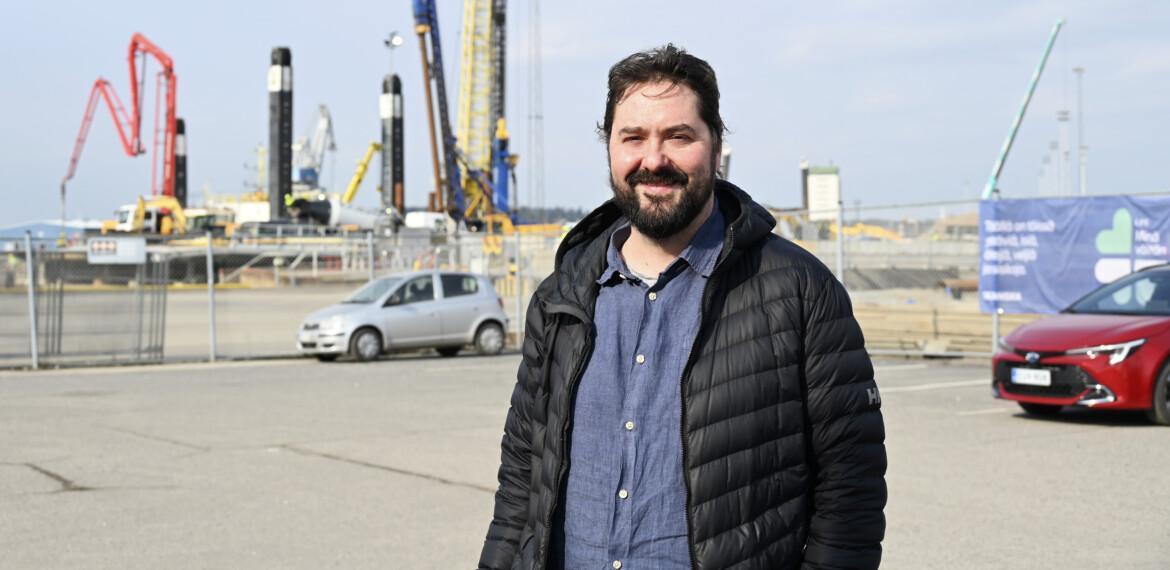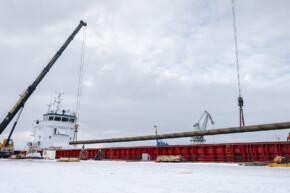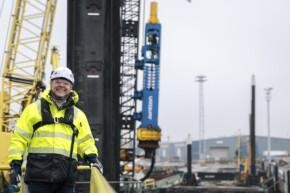The port quay’s most imposing pile is taller than the tower of Turku Cathedral
When a quay is built on a clay seabed, a tall steel pile is the mark of a safe harbour. The structures of the new quays at the Port of Turku are exceptionally impressive.

The quays are easily overshadowed in news about the new port area with its magnificent terminals and artwork. Although the quays are barely noticeable, they are among the most important elements of the port. Ferry Terminal Turku’s two quays (S1 and S2) are definitely worth shining a spotlight on, as they are exceptionally spectacular structures. If one of them were to be lifted onto dry land, it would be taller than Parolanpuisto water tower with a width of more than 200 metres.
The structure is topped off by a storm bollard that is anchored with 90-metre steel rods that are taller than the tower of Turku Cathedral.
“Most quays are unique, even though the ships that are moored to them are the same size. The foundation conditions have a significant impact on the construction of quays ”, says Kim Andersson-Berlin, Managing Director of the engineering firm Profund Oy.
In Turku, the foundation conditions mean clay, a very thick and soft layer of clay. On top of the clay, there is a layer of old filling soil and a stone foundation on which the area has been filled. The stones of the foundation are piled on a bed of twig layers as thick as an arm. And then there are also the remains of previous quay structures. The solid rock into which the piles should be anchored is unfortunately deep down.
Hydraulic engineers avoid building in water
“FTT is a big and important project for us, but not unusually challenging. I think we succeeded well in designing a very functional quay structure”, Andersson-Berlin assesses.
Even though, as a company, Profund is only four years old, its employees collectively have more 40 years of experience in geotechnical engineering. At his previous job, Andersson-Berlin, M.Sc. (underwater construction), was involved in designing, for example, quays for the Port of Kapellskär and Stockholm Norvik Port.
“Underwater construction is more difficult than ordinary construction. The primary rule is not to build underwater structures in the water. Our aim is to complete the structures on dry land.”

In the Port of Turku, this was well understood, since the desire was for the construction to involve the use of full length piles with no splices. In other words, pile lengths would not be welded together on site, i.e. at sea. If they were connected like that, it might result in a poor quality of work.
“In my opinion, the Port of Turku is a great client. They have a sufficient view of what they need and they also know to ask questions.”
The storm bollard must withstand 300 tons of pull
Part of the quay solution includes tension piles, which the contractor drives deep into the moraine. Profund calculated their pull capacity and assured their load capacity using PDA measurements. These piles are almost 50 metres long, so this quay will be a massive underwater structure.
One of the few exceptions is the storm bollard, which will serve as a ship mooring point on the quay. It has to withstand 300 tonnes of pull. For this reason, 90-metre tensile steel rods, called rock anchors, will need to be anchored to the bedrock.
The piling work for Quay S1 got underway in March and the initial plan for Quay S2 has been designed. The test piling for Quay S2 will be initiated during the summer. These piles will serve as the base for reinforced concrete beams and the main platform.
Text: Sari Järvinen
Photos: Sari Järvinen ja Profund Oy
Profund Oy
- Provides expert geoconstruction services
- Specialises in quay structure design
- Customers include the State, municipalities, ELY Centres, large industrial operators and contractors
- The company is based in Turku and has six employees.


